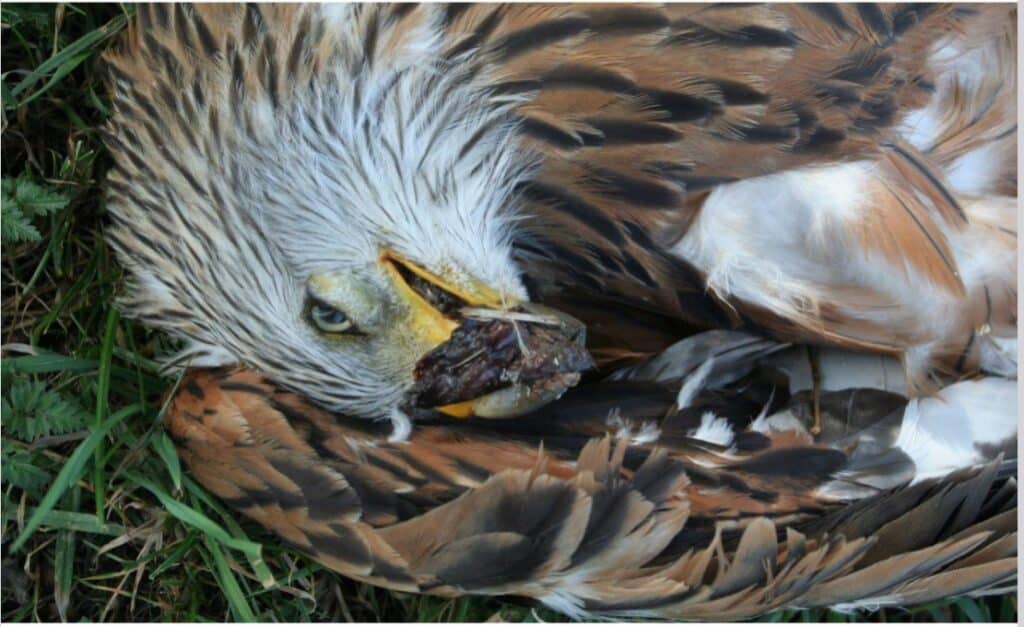Police in Norfolk are appealing for information after tests revealed a Red Kite discovered dead in North Creake had died from suspected insecticide poisoning.
Officers from Norfolk Police’s Operation Randall team have been investigating the death of the protected bird of prey, which was found by a member of the public in a field in North Creake in August 2023 with no obvious physical injuries (eg gunshot wounds or collision with overhead wires).
Because it was not clear how the kite had died, further tests were ordered. A post-mortem examination carried out at the end of November through the Wildlife Incident Investigation Scheme (WIIS) – which makes enquiries into the death or illness of wildlife, pets and beneficial invertebrates that may have resulted from pesticide poisoning – detected a number of pesticides and insecticides, including very high levels of Bendiocarb which has been concluded as the likely cause of death.
Wildlife officer PC Chris Shelley is quoted on the Norfolk Police website saying:
“[We] now know the levels of Bendiocarb contained within the samples taken from the bird have not come from the approved use of such a product.
“I have to conclude that this product has been used illegally in very close proximity to where the bird was recovered.“
What is bendiocarb?
All birds of prey are protected by law, and the laying of poison baits in the open countryside has been illegal for over 100 years. Birds are still being poisoned though. The RSPB Birdcrime report noted 36 poisonings in the UK in 2021 (victims included 12 Common Buzzards, 10 Red Kites, two Peregrines, one Golden Eagle, and one White-tailed Eagle), and there have been 64 confirmed incidents of abuse of banned or highly toxic chemicals to target birds of prey in Northern Ireland alone since 2009.
As the RSPB’s highly experienced investigator Guy Shorrock wrote in November 2021, “we are still a long way from removing the cancer of illegal poisoning from our countryside“, adding that bendiocarb “has increasingly become the poisoner’s weapon of choice”.
But what is bendiocarb? As we explain in our Protectors of the Wild page on Poisoning and Poisoned Baits, Bendiocarb is an acutely toxic carbamate insecticide used in public health and agriculture against a wide range of disease vector insects (it is used in malaria control, for example).
Pure bendiocarb is highly toxic to birds (and to important pollinators including honey bees). It is so toxic that it has been banned in Scotland since 2005 and even possession is considered a serious offence. In England, bendiocarb is licenced for (diluted) use as an ingredient in a number of products, but they are intended for the indoor control of certain insects such as ants and wasps.

If benidiocarb is meant to be used indoors how are birds of prey like Red Kites ingesting it?
By feeding on poisoned baits – often pheasant or rabbit carcasses split open and dosed with poison – left in the open by gamekeepers or landowners to attract and illegally kill birds of prey.
Carrion-feeding birds of prey are especially vulnerable to poisoned baits, and sadly, this Red Kite joins a list of raptors poisoned with Bendiocarb in the last five years that includes:
– a Red Kite poisoned in North Yorkshire in March 2019 with Bendiocarb and Isofenphos (Northern England Raptor Forum)
– a Red Kite found poisoned near Scarmpston, North Yorkshire in April 2020: tests found a combination of Brodifacoum and Bendiocarb. (Northern England Raptor Forum)
– a Buzzard killed in Nidderdale by a combination of pesticides including Bendiocarb (three were found in the buzzard’s gizzard and crop with a fourth pesticide detected in its kidney).
– an adult Peregrine found dead on top of the remains of a wood pigeon in May 2020 on National Trust land in the Upper Derwent Valley (see Peregrine poisoned in Peak District National Park).
– a young Peregrine found poisoned near Barnsley in July 2020 ( RSPB Community Our Work).
– a young White-tailed Eagle from the Isle of Wight reintroduction scheme found dead on a shooting estate in West Sussex in October 2021.
– two White-tailed Eagles found poisoned on a grouse moor in Northern Ireland in May 2023.
What should we do if we find a dead bird of prey that may have been poisoned?
It’s clear that had the member of the public who found this bird NOT reported it to the police, this incident would have never been recorded. It is critical that any suspicious death of a bird of prey is reported to the police or to RSPB Investigations as quickly as possible (before the corpse disintegrates and any poisons are leached away into the soil).
Not every dead bird of prey we find will have been poisoned of course. Avian Flu has been found in birds of prey such as Peregrine Falcon, Hen Harrier, Buzzard, White-tailed Eagle and Golden Eagle, and of course sometimes birds simply die and their bodies are found soon after. However, especially if near a shooting estate, any unmarked bird of prey that is lying dead for no apparent reason may have been poisoned and a crime committed.
If that is the case, photograph the body and report it.
Another reaction might be to pick up the body ‘for evidence’. Please note that we should NOT be picking up dead raptors without being extremely careful. Please DO NOT TOUCH ANYTHING with your bare hands. Modern poisons like bendiocarb or carbofuran are extremely dangerous. Just a few grains or granules will kill a bird of prey by breaking down its nervous system, and the poison can be quickly absorbed through our own skin.

-
We’ve given advice on our Protectors page about how to Recognise, Record, and Report Poisonings and Poisoned Baits

